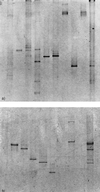rpoB-based microbial community analysis avoids limitations inherent in 16S rRNA gene intraspecies heterogeneity
- PMID: 10919794
- PMCID: PMC92158
- DOI: 10.1128/AEM.66.8.3376-3380.2000
rpoB-based microbial community analysis avoids limitations inherent in 16S rRNA gene intraspecies heterogeneity
Abstract
Contemporary microbial community analysis frequently involves PCR-amplified sequences of the 16S rRNA gene (rDNA). However, this technology carries the inherent problem of heterogeneity between copies of the 16S rDNA in many species. As an alternative to 16S rDNA sequences in community analysis, we employed the gene for the RNA polymerase beta subunit (rpoB), which appears to exist in one copy only in bacteria. In the present study, the frequency of 16S rDNA heterogeneity in bacteria isolated from the marine environment was assessed using bacterial isolates from the red alga Delisea pulchra and from the surface of a marine rock. Ten strains commonly used in our laboratory were also assessed for the degree of heterogeneity between the copies of 16S rDNA and were used to illustrate the effect of this heterogeneity on microbial community pattern analysis. The rock isolates and the laboratory strains were also used to confirm nonheterogeneity of rpoB, as well as to investigate the versatility of the primers. In addition, a comparison between 16S rDNA and rpoB PCR-DGGE (denaturing gradient gel electrophoresis)-based community analyses was performed using a DNA mixture of nine isolates from D. pulchra. Eight out of 14 isolates from D. pulchra, all rock isolates, and 6 of 10 laboratory strains displayed multiple bands for 16S rDNA when analyzed by DGGE. There was no indication of heterogeneity for either the rock isolates or the laboratory strains when rpoB was used for PCR-DGGE analysis. Microbial community pattern analysis using 16S rDNA PCR-DGGE showed an overestimation of the number of laboratory strains in the sample, while some strains were not represented. Therefore, the 16S rDNA PCR-DGGE-based community analysis was proven to be severely limited by 16S rDNA heterogeneity. The mixture of isolates from D. pulchra proved to be more accurately described using rpoB, compared to the 16S rDNA-based PCR-DGGE.
Figures



References
-
- Clayton R A, Sutton G, Hinkle P S, Bult C, Fields C. Intraspecific variation in small-subunit rRNA sequences in Genbank—why single sequences may not adequately represent prokaryotic taxa. Int J Syst Bacteriol. 1995;45:595–599. - PubMed
-
- Felske A, Vancanneyt M, Kersters K, Akkermans A D L. Application of temperature-gradient gel electrophoresis in taxonomy of coryneform bacteria. Int J Syst Bacteriol. 1999;49:113–121. - PubMed
Publication types
MeSH terms
Substances
LinkOut - more resources
Full Text Sources
Other Literature Sources
Research Materials

